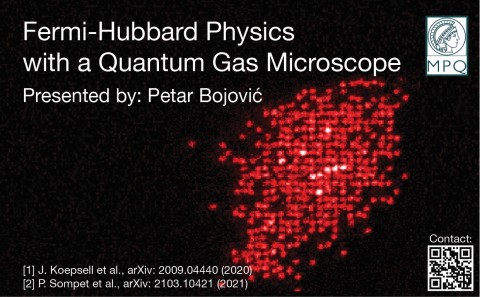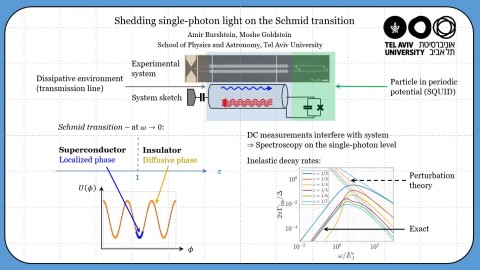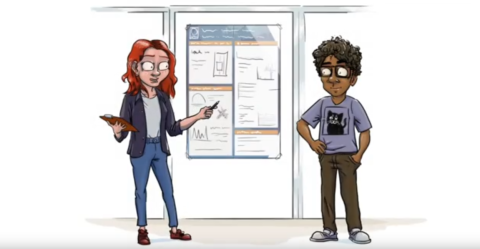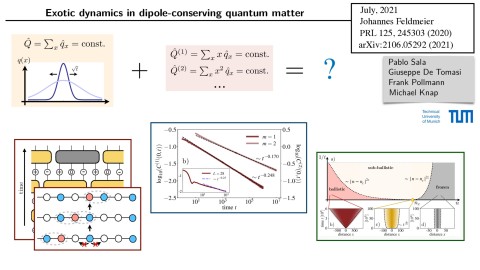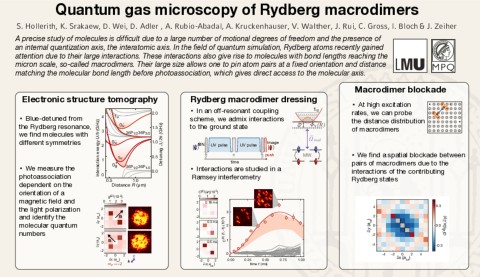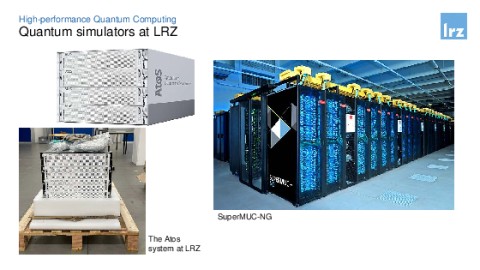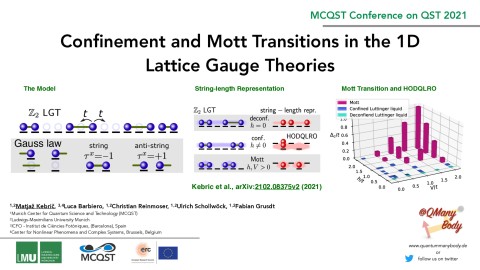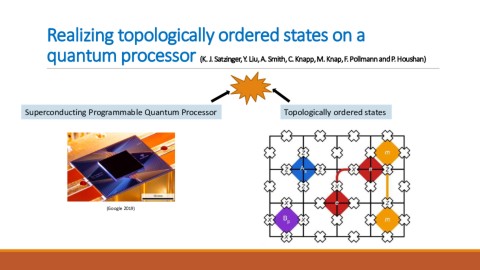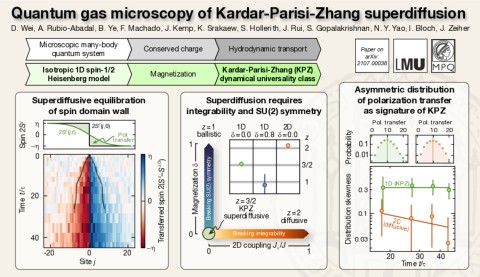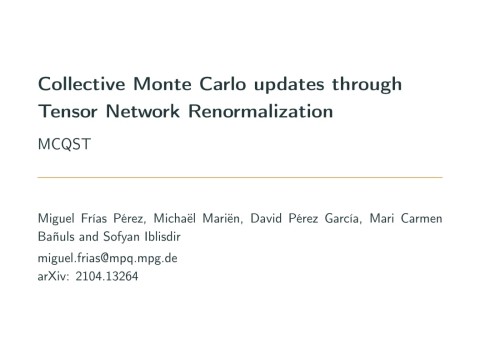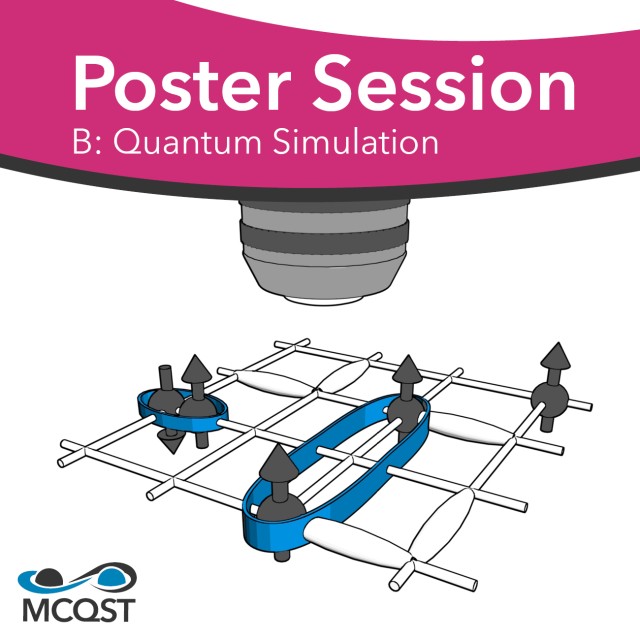
B. Quantum Simulation
Poster Session I | All posters are presenting
Monday, 19 July 18:00 - 19:30 CEST
Poster Session II | All posters are presenting
Wednesday, 21 July 11:00 - 12:30 CEST
Abstract
Fermi-Hubbard Physics with a Quantum Gas Microscope
Ultracold fermions in optical lattices have emerged as a powerful tool in the quantum simulation of the Fermi-Hubbard model. Access to full density and spin resolution [1] of our 6Li quantum gas microscope has enabled us to study the interplay between spin and charge in doped antiferromagnets. With a technical addition of site-resolved potential shaping, we are able to explore new system geometries in which interesting physical phenomena are more dominant and more easily measurable. In 2D, the competition between the spin and charge degrees of freedom guides the phase transition from an anomalous metal to a conventional Fermi liquid [2]. Accessibility to single-site microscopic observables allows us to measure a wide range of correlators, in particular higher order correlators which are studied as a function of doping. At lower doping the system exhibits magnetic polarons, i.e., holes with a dressed cloud of spins. At higher doping, the system is characterized by incommensurate magnetic fluctuations and altered correlations. The crossover is completed for hole doping of around 30%. In ladder systems, we are able to experimentally realize the paradigmatic example of symmetry protected topological (SPT) phase – the spin-1 Haldane chain [3]. This is achieved by creating a tailored spin-1/2 ladder geometry which maps directly to the spin-1 Haldane chain [4]. We detect a finite non-local string correlator in the bulk and localized spin-1/2 states at the edges, as some of the main characteristics of the SPT phase. The robustness of the state is confirmed by tuning the ratio of the leg to rung coupling of the ladder. Finally, we go beyond the spin model and explore the effect of charge fluctuation on the SPT phase in the general Hubbard regime. [1] J. Koepsell et al., Phys. Rev. Lett. 125, 010403 (2019) [2] J.Koepsell et al., arXiv: 2009.04440 (2020) [3] P. Sompet et al., arXiv: 2103.10421 (2021) [4] White et al., Phys. Rev. B 53, 52 (1996)
Authors: P. Bojovic(1,2), S. Hirthe(1,2), D. Bourgund(1,2), T. Chalopin(1,2), J. Koepsell(1,2), P. Sompet(1,2,3), G. Salomon(1,2,4), C. Gross(1,2,5), T. A. Hilker(1,2), A. Bohrdt(7,8), Y. Wang(8), F. Grusdt(2,6), E. Demler(8), J. Bibo(2,7), R. Verresen(8), F. Pollmann(2,7), I. Bloch(1,2,5,)
Affiliations: 1 - Max-Planck-Institut für Quantenoptik, Garching, Germany 2 - Munich Center for Quantum Science and Technology, Munich, Germany 3 - Chiang Mai University, Chiang Mai, Thailand 4 - Universität Hamburg, Germany 5 - Eberhard-Karls-Universität, Tübingen, Germany 6 - Ludwig-Maximilians-Universität, München, Germany 7 - Technical University of Munich, Garching, Germany 8 - Harvard University, Cambridge MA, USA
Abstract
Shedding single-photon light on the Schmid transition
The Schmid transition [1,2] is a superconductor to insulator quantum phase transition in a system of a periodic potential coupled to a dissipative environment. Since its prediction, almost 40 years ago, the transition has never been observed experimentally, in large part due to difficulties in performing DC measurements without disturbing the system. We present an ongoing attempt to observe the transition, using AC measurements of a system where the periodic potential is coupled to a transmission line that supports the propagation of microwave photons. By choosing suitable parameters for the transmission line, one may probe the properties of the system modes, both inelastic decay rates and mode shifts, on the single photon level [3,4]. We calculate these properties, and show that while perturbation theory is invalid at low frequencies, and therefore insufficient in the context of the transition, one may obtain an exact solution using the integrability property of the sine-Gordon model. This exact solution may aid an ongoing experimental endeavor by the Manucharyan group from the university of Maryland. [1] A. Schmid, Phys. Rev. Lett. 51, 1506 (1983) [2] S. A. Bulgadaev, Journal of Exp. and Th. Phys. 63 369 (1986) [3] A. Burshtein, R. Kuzmin, V. Manucharyan and M. Goldstein, Phys. Rev. Lett. 126, 137701 (2021) [4] R. Kuzmin, N. Grabon, M. Mehta, A. Burshtein, M. Goldstein, M. Houzet, L. Glazman and V. Manucharyan, Phys. Rev. Lett. 126, 197701 (2021)
Authors: Amir Burshtein [1] and Moshe Goldstein [1]
Affiliations: [1] Raymond and Beverly Sackler School of Physics and Astronomy, Tel Aviv University, Tel Aviv 6997801, Israel
B.3 David Castells Graells
Max Planck Institute of Quantum Optics
Abstract
Atomic waveguide QED with atomic dimers
Quantum emitters coupled to a waveguide is a paradigm of quantum optics, whose essential properties are described by waveguide quantum electrodynamics (QED). We study the possibility of observing the typical features of the conventional waveguide QED scenario in a system where the role of the waveguide is played by a one-dimensional subwavelength atomic array. For the role of emitters, we propose to use anti-symmetric states of atomic dimers - a pair of closely spaced atoms - as effective two-level systems, which significantly reduces the effect of free-space spontaneous emission. We solve the dynamics of the system both when the dimer frequency lies inside and when it lies outside the band of modes of the array. Along with well-known phenomena of collective emission into the guided modes and waveguide mediated long-range dimer--dimer interactions, we uncover significant non-Markovian corrections which arise from both the finiteness of the array and through retardation effects.
Authors: David Castells-Graells (1,2,3), Daniel Malz (1,3) Cosimo C. Rusconi (1,3), J. Ignacio Cirac (1,3)
Affiliations: 1. Max-Planck-Institut für Quantenoptik 2. Technical University of Munich 3. Munich Center for Quantum Science and Technology
Abstract
Exotic dynamics in dipole-conserving quantum matter
s advances in the technology of quantum simulation provide increasing control over complex many-body systems, the study of their out-of-equilibrium properties is gaining attention. While a full theoretical description of the unitary evolution is in general challenging to obtain, we can rely on certain notions of universality to describe the quantum thermalization process: After a local equilibration time, emergent hydrodynamics describes the diffusive transport of conserved quantities through the system, accompanied by a linear-in-time spatial growth of initially local operators. Here we discuss how such universal aspects of the late time dynamics in quantum many-body systems can be drastically altered in the presence of kinetic constraints. In particular, we first show how systems that are constrained to conserve the dipole moment of an associated global charge generally display anomalously slow subdiffusive transport, consistent with recent cold atom experiments. We then go on to demonstrate how the presence of constraints in such fractonic quantum matter - characterized by excitations with restricted mobility - can further lead to an anomalously slow spreading of operators.
Authors: Johannes Feldmeier (1,2), Pablo Sala (1,2), Giuseppe De Tomasi (3), Frank Pollmann (1,2), Michael Knap (1,2)
Affiliations: (1) Technical University Munich (2) Munich Center for Quantum Science and Technology (MCQST) (3) T.C.M. Group, Cavendish Laboratory, J. J. Thomson Avenue, Cambridge CB3 0HE, United Kingdom
B.5 Kevin Hemery
Technical University Munich
Abstract
Correlation Clusters in Many-Body Localized Systems
We introduce techniques for analysing the structure of quantum states of many-body localized (MBL) spins chains by identifying correlation clusters from pairwise correlations. These techniques proceed by interpreting pairwise correlations in the state as a weighted graph, which we analyse using an established graph theoretic clustering algorithm. We validate our approach by studying the eigenstates of a disordered XXZ spin chain across the MBL to ergodic transition, as well as the non-equilibrium dyanmics in the MBL phase following a global quantum quench. We successfully reproduce theoretical predictions from finite size scaling analysis of the MBL transition. Furthermore, we identify a clear signature of many-body dynamics analogous to the logarithmic growth of entanglement. The techniques that we introduce are computationally inexpensive and in combination with matrix product state methods allow for the study of large scale localized systems. Moreover, the correlation functions we use are directly accessible in a range of experimental settings including cold atoms.
Authors: Kevin Hemery, Adam Smith, Frank Pollmann
Affiliations: Department of Physics, TFK, Technische Universität München, James-Franck-Strasse 1, 85748 Garching, Germany Department of Physics, TFK, Technische Universität München, James-Franck-Strasse 1, 85748 Garching, Germany Department of Physics, TFK, Technische Universität München, James-Franck-Strasse 1, 85748 Garching, Germany; Munich Center for Quantum Science and Technology (MCQST), Schellingstr. 4, D-80799 München
Abstract
Quantum gas microscopy of Rydberg macrodimers
A precise study of molecules is difficult due to the large number of motional degrees of freedom like vibration and rotation. Rydberg atoms recently gained attention due to their large interactions. These interactions also give rise to molecular states with bond lengths reaching the micron scale. These bound pairs of Rydberg atoms are called macrodimers. The large size allows to pin atom pairs at a fixed orientation and a distance matching the molecular bond length before photoassociation. This allows to study the electronic structure of the molecules at a control level usually not present in molecular physics. Applying this technique in a quantum gas microscope, we identify the molecular quantum numbers of various macrodimer states and study their response to external fields. Furthermore, we show how a off-resonant coupling to Rydberg macrodimers enables the engineering of Ising Hamiltonians. Finally, for optimized coupling conditions we, are able to observe a novel blockade mechanism between pairs of macrodimers.
Authors: S. Hollerith (1,2), K. Srakaew (1,2), D. Wei (1,2), D. Adler (1,2), A. Rubio-Abadal (1,2), A. Kruckenhauser (3), V. Walther (4), J. Rui (1,2), C. Gross (1,2,5), I. Bloch (1,2,6), J. Zeiher (1,2)
Affiliations: (1) Max-Planck-Institut für Quantenoptik, 85748 Garching, Germany, (2) Munich center for Quantum Science and Technology (MCQST), 80799 Munich, Germany (3) Institute for Quantum Optics and Quantum Information (IQOQI), Innsbruck, Austria (4) ITAMP, Harvard-Smithsonian Center of Astrophysics, Cambridge, MA, USA (5) Physikalisches Institut, Eberhard Karls Universität, 72076 Tübingen, Germany (6) Ludwig-Maximilians-Universität, Fakultät für Physik, 80799 München, Germany
B.7 Lukas Homeier
LMU Munich
Abstract
Strong pairing in bilayer antiferromagnetic Mott insulators
n our work, we propose a strong paring mechanism in a mixD Fermi-Hubbard model with binding energies proportional to [1]. The attraction can be explained by starting from single dopants in a model with anti-ferromagnetic (AFM) superexchange and hole motion . The motion of one chargon then retraces the path of frustrated magnetic bonds from the motion of a second chargon leading to a linear string-like potential [2]. At and low-doping, tightly-bound pairs of chargons can form, which are rather static. However, we also find strongly bound pairs, or bipolarons, that are highly mobile in the strong-coupling regime, , with a quasi-particle mass in contrast to the common believe of static bipolarons. Both regimes are studied in both a ladder (d=1) and a bilayer model (d=2) for which we have conducted numerical simulations using the density matrix renormalization group (DMRG) technique and compared the results to a parton dimer model and its extensions. At high dopings the model exhibits a BCS phase with d-wave superconducting order [3]. Hence, the model could provide a platform to study a BEC-to-BCS crossover with sufficiently high and to gain insight into the related 2D Fermi-Hubbard model. Bilayer Fermi-Hubbard models have recently been realised in cold atom experiments [4] and thus state-of-the-art experiments are ready to directly observe the proposed pairing mechanism. In the low-doping limit, where the hole dopants take the role of charge carriers, a microscopic pairing mechanism is still lacking and with it many open question: the origin of the pseudogap or the strange metal phase [5]. [1] Bohrdt, Homeier et al., Strong pairing in bilayer AFMIs, in preparation (2021) [2] Grusdt et al., PRX 8 (2018) [3] Bohrdt, Homeier et al., Exploration of doped quantum magnets with ultracold atoms, in preparation (2021) [4] Gall et al., Nature 589 (2021) [5] Keimer et al., Nature 518 (2015)
Authors: Annabelle Bohrdt (1,2,3,4), Lukas Homeier (5,2), Eugene Demler (4,6), Fabian Grusdt (5,2)
Affiliations: (1) Department of Physics and Institute for Advanced Study, Technical University of Munich, D-85748 Garching, Germany (2) Munich Center for Quantum Science and Technology (MCQST), Schellingstr. 4, D-80799 München, Germany (3) ITAMP, Harvard-Smithsonian Center for Astrophysics, Cambridge, MA 02138, USA (4) Department of Physics, Harvard University, Cambridge, MA 02138, USA (5) Department of Physics and Arnold Sommerfeld Center for Theoretical Physics (ASC), Ludwig-Maximilians-Universität München, Theresienstr. 37, München D-80333, Germany (6) Institute for Theoretical Physics, ETH Zurich, 8093 Zurich, Switzerland
Abstract
Quantum simulators at LRZ: strategy and benchmarks
Current quantum hardware is still experimental under many viewpoints and only limited chances for access are offered to the community. Therefore, simulation of quantum computation is a viable alternative for researchers and programmers working on quantum algorithm development. We present in this poster LRZ's quantum simulators strategy and some preliminary benchmarking results regarding our newly installed Atos Quantum Learning Machine (QLM). In the regime of moderate qubit count and for users preferring a Python-based API, the QLM is a very suitable simulation tool. However, our early experience shows that for a qubit count exceeding 30 and/or for users with deeper HPC knowledge, running a software simulator like Intel-QS on SuperMUC-NG is a convenient alternative.
Authors: Stefan Huber, Luigi Iapichino, Martin Ruefenacht
Affiliations: Leibniz Supercomputing Centre of the Bavarian Academy of Sciences and Humanities, Garching
Abstract
Confinement and Mott Transitions in the 1D Lattice Gauge Theories
Lattice gauge theories (LGTs) have become a valuable tool to study strongly correlated condensed matter systems. This becomes in particular interesting when gauge degrees of freedom are coupled to matter since they allow us to study the complex problem of confinement. However, when the lattice is doped and matter becomes dynamical the clear notion of confinement becomes complicated. Here we study a one-dimensional (1D) Z2 LGT model where the gauge fields are coupled to dynamical charges with confining Z2 electric field and repulsive nearest-neighbor interactions. We map our model to a local string-length Hamiltonian where we link the confinement in the Z2 LGT model to a broken translational symmetry in the string- length basis. In addition we study the Mott transition of the charges at a specific filling of n = 2/3. We find that the metallic phase of the confined Luttinger liquid is characterized by a hidden off-diagonal quasi-long-range order. Furthermore we map the 1D Z2 LGT model to a t − Jz model which can be implemented in cold atom experiments by using the Rydberg dressing schemes; thus, we propose a way to directly test our theoretical predictions. https://arxiv.org/abs/2102.08375
Authors: Matjaž Kebrič(1,2), Luca Barbiero(3,4), Christian Reinmoser(1,2), Ulrich Schollwöck(1,2), Fabian Grusdt(1,2)
Affiliations: (1)Department of Physics and Arnold Sommerfeld Center for Theoretical Physics (ASC), Ludwig-Maximilians-Universität München, Theresienstr. 37, München D-80333, Germany (2) München Center for Quantum Science and Technology (MCQST), Schellingstr. 4, D-80779 München, Germany (3) ICFO - Institut de Ciències Fotòniques, The Barcelona Institute of Science and Technology, 08860 Castelldefels (Barcelona), Spain (4)Center for Nonlinear Phenomena and Complex Systems, Universite Libre de Bruxelles, CP 231, Campus Plaine, B-1050 Brussels, Belgium
Abstract
Realizing topologically ordered states on a quantum processor
The discovery of topological order has revolutionized the understanding of quantum matter in modern physics and provided the theoretical foundation for many quantum error correcting codes. Realizing topologically ordered states has proven to be extremely challenging in both condensed matter and synthetic quantum systems. Here, we prepare the ground state of the toric code Hamiltonian using an efficient quantum circuit on a superconducting quantum processor. We measure a topological entanglement entropy near the expected value of $\ln2$, and simulate anyon interferometry to extract the braiding statistics of the emergent excitations. Furthermore, we investigate key aspects of the surface code, including logical state injection and the decay of the non-local order parameter. Our results demonstrate the potential for quantum processors to provide key insights into topological quantum matter and quantum error correction.
Authors: K. J. Satzinger (1) Y. Liu (2,3), A. Smith (4), C. Knapp (5,6), M. Knap (2,3), F. Pollmann (2,3) and P. Roushan (1)
Affiliations: (1) Google Quantum AI, Mountain View, CA, USA (2) Department of Physics, Technical University of Munich, 85748 Garching, Germany (3) Munich Center for Quantum Science and Technology (MCQST), Schellingstr. 4, 80799 M{\"u}nchen, Germany (4) Centre for the Mathematics and Theoretical Physics of Quantum Non-Equilibrium Systems, University of Nottingham, Nottingham, NG7 2RD, UK (5) Department of Physics and Institute for Quantum Informationand Matter, California Institute of Technology, Pasadena, CA, USA (6) Walter Burke Institute for Theoretical Physics, California Institute of Technology, Pasadena, CA, USA
Abstract
Probing Quantum Phases and Dynamics with Dilute-Gas Bose-Einstein Condensates
Quantum gases at temperatures near absolute are powerful testbeds for probing complex dynamics connected to open questions in many areas of modern physics, including quantum optics, quantum information, or condensed matter physics. At Washington State University we perform a variety of experiments involving spin-orbit coupled Bose-Einstein condensates (BECs) and BECs in optical lattices to investigate exotic quantum phenomena such as negative effective mass hydrodynamics, a one-way spin switch, spin-dependent emerging lattices, superfluid stripe phases, soliton formation, and more. Our research provides fundamental insights into quantum dynamics but also motivates new device paradigms for quantum technologies with applications to spintronics, quantum analog simulation or quantum metrology.
Authors: M. K. H. Ome, A. Mukhopadhyay, E. Crowell, T. M. Bersano, M. Mossman, S. Mossman and P. Engels
Affiliations: Washington State University
Abstract
Quantum gas microscopy of Kardar-Parisi-Zhang superdiffusion
The Kardar-Parisi-Zhang (KPZ) universality class describes the coarse-grained behavior of a wealth of classical stochastic models. Surprisingly, it was recently conjectured to also describe spin transport in the one-dimensional quantum Heisenberg model. We test this conjecture by experimentally probing transport in a cold-atom quantum simulator via the relaxation of domain walls in spin chains of up to 50 spins. We find that domain-wall relaxation is indeed governed by the KPZ dynamical exponent $z = 3/2$, and that the occurrence of KPZ scaling requires both integrability and a non-abelian SU(2) symmetry. Finally, we leverage the single-spin-sensitive detection enabled by the quantum-gas microscope to measure a novel observable based on spin-transport statistics, which yields a clear signature of the non-linearity that is a hallmark of KPZ universality.
Authors: David Wei (1,2), Antonio Rubio-Abadal (1,2), Bingtian Ye (3), Francisco Machado (3,4), Jack Kemp (3), Kritsana Srakaew (1,2), Simon Hollerith (1,2), Jun Rui (1,2), Sarang Gopalakrishnan (5,6), Norman Y. Yao (3,4), Immanuel Bloch (1,2,7), Johannes Zeiher (1,2)
Affiliations: (1) Max-Planck-Institut für Quantenoptik, Garching, Germany, (2) Munich Center for Quantum Science and Technology (MCQST), München, Germany, (3) Department of Physics, University of California, Berkeley, USA, (4) Materials Science Division, Lawrence Berkeley National Laboratory, Berkeley, USA, (5) Department of Physics, The Pennsylvania State University, University Park, USA, (6) Department of Physics and Astronomy, College of Staten Island, Staten Island, USA, (7) Fakultät für Physik, Ludwig-Maximilians-Universität, München, Germany
B.14 Zhiyuan Wei
Max Planck Institute for Quantum Optics
Abstract
Sequential generation of tensor network states
In the first part of this poster, we discuss two implementations to generate photonic matrix product states using sequential protocol. One implementation is based on a Rydberg-blockaded atomic array, which generates optical entangled photons and can distribute them into several directions in free space. Another is based on a microwave cavity dispersively coupled to a transmon, which generates microwave entangled photons. We show both implementations can generate a large number of entangled photons. In the second part (will be shown in a separate slide), we introduce a class of state in a lattice that can be generated by applying unitaries acting on plaquettes of overlapping regions, which we call plaquette sequentially generated projected entangled-pair states (psgPEPS). We show psgPEPS of both static qubits and flying qubits can be prepared in any dimension with a quantum circuit whose depth grows linearly with the maximal length of the lattice. We also show psgPEPS contain isometric tensor network states (isoTNS) and the sequentially generated states (SGS), which include important states like the graph states and string-net liquids (including the toric code state). At last, we propose to efficiently generated photonic psgPEPS by extending our microwave cavity + transmon protocol discussed above.
Authors: 1. Max-Planck-Institut für Quantenoptik, Hans-Kopfermann-Straße 1, D-85748 Garching, Germany 2. Munich Center for Quantum Science and Technology (MCQST), Schellingstr. 4, D-80799 München, Germany 3 Instituto de Física Fundamental IFF-CSIC, Calle Serrano 113b, Madrid 28006, Spain
Affiliations: FZhi-Yuan Wei(1,2), Daniel Malz(1,2), Alejandro Gonzalez Tudela(3), Ignacio Cirac(1,2)
Abstract
Collective Monte Carlo updates through tensor network renormalization
We introduce a Metropolis–Hastings Markov chain for Boltzmann distributions of classical spin systems. It relies on approximate tensor network contractions to propose correlated collective updates at each step of the evolution. We present benchmark computations for a wide variety of instances of the two-dimensional Ising model, including ferromagnetic, antiferromagnetic, (fully)frustrated and Edwards-Anderson spin glass cases, and we show that, with modest computational effort, our Markov chain achieves sizeable acceptance rates, even in the vicinity of critical points. In each of the situations we have considered, the Markov chain compares well with other Monte Carlo schemes such as the Metropolis or Wolff’s algorithm: equilibration times appear to be reduced by a factor that varies between 40 and 2000, depending on the model and the observable being monitored. We also present an extension to three spatial dimensions, and demonstrate that it exhibits fast equilibration for finite ferro- and antiferromagnetic instances. Additionally, and although it is originally designed for a square lattice of finite degrees of freedom with open boundary conditions,the proposed scheme can be used as such, or with slight modifications, to study triangular lattices, systems with continuous degrees of freedom, matrix models, a confined gas of hard spheres, or to deal with arbitrary boundary conditions.
Authors: Miguel Frías Pérez, Michaël Mariën, David Pérez García, Mari CarmenBañuls and Sofyan Iblisdir
Affiliations: Max-Planck-Institut für Quantenoptik, Hans-Kopfermann-Straße 1, 85748 Garching, Germany

